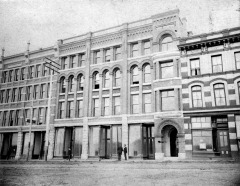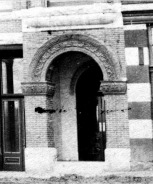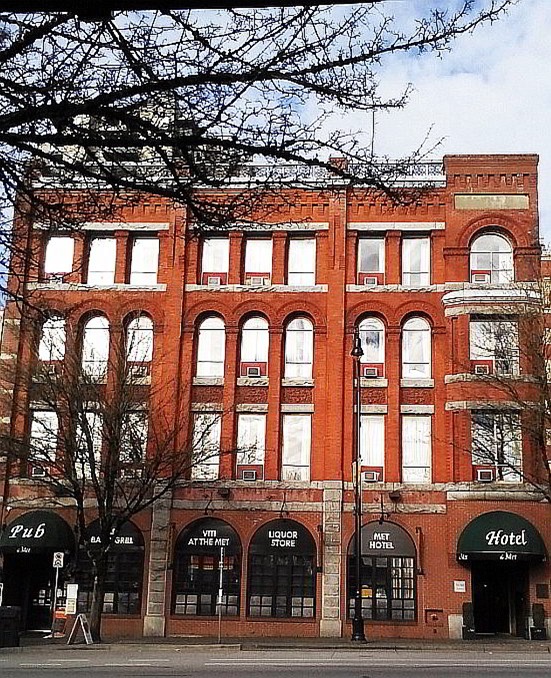Burr Block–In the Room of the Second Looking-Glass
In 1892 WH Burr erected a new building in the city of New Westminster. Called the "Burr Block" the structure was sandwiched between the new Begbie Block and the Queen’s Hotel, on the upper part of Columbia Street, in the same block as the old Columbia Hotel.
A contemporary review of the building stated:
"The Burr Block, adjoining the Queen’s Hotel, a splendid structure, 132 x 66 feet, four stories high, and basement, is another building which would be a credit to any city.
It is built of bright pressed brick and granite, with terra cotta trimmings.
The main entrance is covered by a massive arch, supported by handsome pillars, the architecture of the whole being both striking and substantial.
Three stores occupy the ground floor, and the upper flats are divided into cozy and handy suites, suitable either for homes or offices.
Broad stairways give access to the upper floors, and the interior is prettily finished in native woods. The building is lighted by electricity and heated with hot water, and the sanitary arrangements are of the most modern order.
Mr Burr is the owner, and Mr GW Grant was the architect."
Building blocks
GW Grant, the architect of the Burr Block, designed dozens of local buildings, including the first Leckie Block in Vancouver.
The builder of the Burr Block was Thomas Hembrough, whom we know from the Leeds Landing brickyard near Port Kells. Although we have seen one story, written many years after the fact, which stated that the bricks for the Burr Block were imported from Holland, it is more likely these were bricks from the Hembrough’s own brickyard.
The first products from Leeds Landing had attracted compliments in the press:
"The brick are well made, have a fine natural finish and in color are unusually handsome."
The same yard also turned out terra cotta and pottery.
Thomas Hembrough built the YMCA building — in the next block down, corner of Church & Columbia— the same year, using Leeds Landing brick and Pender Island granite. So that is likely Pender Island stone that can be seen on the Burr Block.
 |
Left photo shows original shops on ground floor of Burr Block. Right, close-up of arch-way entrance. Vancouver Archives photo. |
 |
Tragic Ending: The Burr Block Suicide
In the early 90’s WH Burr was selling off parcels of his farmland in Delta. He maintained a city residence in the Burr Block, where he lived with his wife Minnie and their young son.
In the spring of 1896 Burr was experiencing symptoms of illness. He complained to a friend of heart palpitations and a sense of impending doom.
On July 2, alone in a front room in the Burr Block, WH Burr kneeled down with a revolver in his hand and shot a bullet through his head. The missile was later picked up from the bed, having ricocheted off the ceiling.
Those who entered the room after could not explain the presence of a second mirror which had not been there before.
Letters he left behind revealed that Burr had great concern for what would happen to his seven year old son after his death, and contemplated taking his son’s life with his own. In the most recent letter, he exhorted his son "to be good and grow up a good man."
The child was missing, but later found down at the other end of Columbia Street, playing in sawdust at the Royal City Mill.
William Henry Burr was one of the oldest pioneers of British Columbia, having been teaching school in Victoria in 1859. He established the landmark Columbia Hotel in the 1860s, participated in the development of Ladner, and established a second landmark building in New Westminster — the existing Burr Block being one of only two downtown buildings to survive the great fire of 1898.
Burr need not have worried about his son’s future. Burr’s widow, remarried. The boy grew up in a second family and had a successful career in real estate. He married and had a family of his own, which included, when he passed away at the ripe old age of 91, six great grandchildren.
The Burr Block on Columbia Street is now occupied by the Met Hotel.
Note: Regarding the origin of the old bricks. It is possible fragments of old bricks can be found on the old property of the brickyard near Port Kells, since subdivided, to compare with the original bricks on this building.
